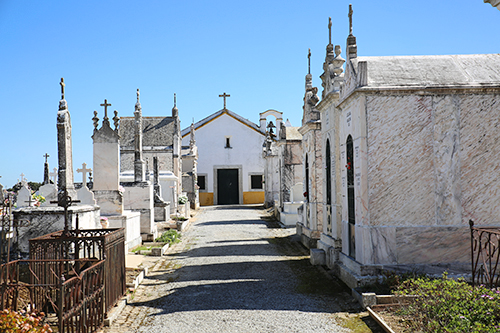 |
Nowadays this small hermitage is inserted inside the municipal cemetery, but is pre-existent to it. It is unknown who or what events may have led to its construction, but it might have been built in the 17th century, since it already existed in 1708, and its architectural appearance is from that same period. It was only in 1871 that the new cemetery of Viana was built in its surroundings, whose location was due to Doctor António José de Sousa, father of António Isidoro de Sousa.
The hermitage is composed of nave and main chapel, covered with a gable roof on the nave; and the main chapel has a dome and a pyramidal spire. The main façade, which had a galilee, was reformulated with a single cloth topped by triangular pediment and central portico with two small side windows. The side façades are buttressed. Inside, the cover has a barrel vault with a single curve in the nave and, in the main chapel, a dome over squinches.
From the Middle Ages until the 19th century, burials were made inside the churches (parochial, convent, cathedral, misericórdias, etc.) and in their vicinity because they were considered sacred grounds, closer to the Divine. However, following the implementation of the new Liberalism political regime in 1820, the Decree-Law of 21th September 1835 was promulgated - during the Cartista administration of Duque de Saldanha – which determined that in each municipality there had to be at least one graveyard outside the localities, for reasons of hygiene and public health. This Decree was complemented with the decree of 28th September 1844, promulgated during the government of Costa Cabral, which prohibited burials in churches and imposed burials to be made in cemeteries.
However, these new determinations were not exempt from controversy and even from wars. To remove the dead from the sacred spaces, where they had been deposited for centuries, seemed, at the time, an aberration. For this reason, the prohibition of burials in churches caused a rebellion in Minho, in 1846, which became known as revolta da Maria da Fonte (Revolution of Maria da Fonte). Following this revolt was the Civil War of Patuleia between Cartistas, who represented the Queen, and the Setembristas/Miguelistas insurgents. This war had a fight in the vicinity of Viana do Alentejo (town that remained faithful to the queen) in October 1846, in the zone of Ferragial d'El Rey. This confrontation, such as the war itself, ended with the Cartistas’ victory.
However, the shortage of resources meant that the cemeteries were not made with the desired speed. The cemetery of Viana appeared, thus, from the presented historical context, but was only executed decades after the determinations of the central government.
In a progressive attitude, Francisco de Melo Cabral e Sousa of Viana determined the construction of Viana’s cemetery first grave, disposition found in his will, dated from 1872. However, its construction may have begun even in the life of the testator, who only passed away in 1875. This mausoleum, located on the main street of the cemetery, is the first on the right side of whoever leaves the hermitage of Santo André (Saint Andrew), and became the Cabral family grave, Majorats of Santa Catarina de Estremoz.
REFERENCES
Arquivo Histórico Municipal de Viana do Alentejo, Administração do Concelho de Viana do Alentejo, Registo de testamentos, Lv007 (ACVA/K/001/Lv007-1875-1879).
CALDEIRA, João Luís Cabral Picão, Morgados de Santa Catarina de Estremoz, 1ª ed., Lisboa, Colibri, 1999.
COSTA, António Carvalho da, Corografia portugueza, e descripçam topografica do famoso reyno de Portugal…., Lisboa, Na Officina de Valentim da Costa Deslandes, 1707, tomo II.
NUNES, Teresa, Maria da Fonte e Patuleia: 1846-1847, Matosinhos, QuidNovi, 2006, (Batalhas da História de Portugal, 16)
SOUSA, João Manuel Santana de, História da Primeira Adega Social Portuguesa, Viana do Alentejo, Câmara Municipal, 1993.
http://www.monumentos.pt/

 Abrir Lista
Abrir Lista MUNICÍPIO DE VIANA DO ALENTEJO
MUNICÍPIO DE VIANA DO ALENTEJO